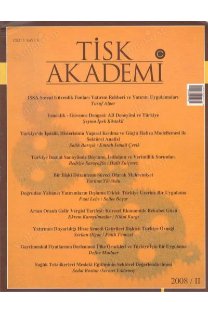Türkiye'de Çocuk ve Yoksulluğu: Ölçüm Yöntemleri ve Yoksulluğun Belirleyicileri
Bu çalışmanın amacı çocuk yoksulluğunun boyutunu farklı göstergeler ışığında incelemek ve yoksulluğun belirleyicilerini tesbit ederek olası müdahale alanlarına ışık tutmaktır. Çalışmanın sonuçları, çocuk yoksulluğunun boyutunun kullanılan gösterge ile değiştiğini, tüketim yoksulluğunun gelir yoksulluğundan daha düşük olduğunu ve kadın ve çocuk emeğinin yoksulluğu azaltıcı etkide bulunduğunu göstermiştir. Yoksulluğun belirleyicileri kullanılan yoksulluk göstergesi ile değişmekle beraber, teoride beklenen sonuçlara paralel olarak yoksulluk riskinin hanenin sahip olduğu üretim kaynaklarıyla doğrudan ilişkili olduğu bulunmuştur. Yine beklenildiği üzere hanedeki bağımlı sayısı arttıkça yoksulluk riski artmaktadır. Hane reisinin çalışma durumunun ve bulunduğu sektörün özellikle de gelir yoksulluğunun önemli belirleyicileri arasında bulunduğu, kamuda olduğu gibi uzun soluklu ve devamlılığı olan işlere sahip hane reislerinin çocuk yoksulluğunu düşürdüğü görülmektedir. Hanehalkı reisinin çalışamama durumunun ise çocuk yoksulluğu için büyük bir risk teşkil ettiği ve yoksullukla mücadelede bu hanelerin/çocukların öncelik taşıması gerekliliği ortaya çıkmaktadır.
Indicators and Determinants of Child Poverty in Turkey
The purpose of this study is to investigate child poverty and its determinants in Turkey. The results show that the incidence of child poverty changes with the definition used, with consumption poverty generally yielding smaller figures than when poverty is measured in terms of household income. Results also show that women’s and children’s work efforts are instrumental in reducing the incidence of poverty. Although the determinants of child poverty changes with the indicators used to measure it, the results are generally in agreement with the theory that poverty very much depends on the resource base of the household and the number of dependents. As would be expected, higher dependency ratios lead to higher rates of poverty among children. The employment status of the household head and the sector he/she is in are important determinants of poverty. Household heads with regular, long-term jobs such as in the public sector reduces the risk of poverty. To the contrary, household heads who are unable to work greatly increase the incidence of poverty among children. In the fight against child poverty, children from such households need to be given top priority.
___
- Atkinson, A.B. (1984), The Economics of Inequality, Oxford: Clarendon Press.
- Atkinson, A.B. ve F. Bourguignon (2000), “Introduction: Income Distribution and Economics”, A.B. Atkinson ve F. Bourguignon F (Der.), Handbook of Income Distribution 1, 1-58, Amsterdam: Elsevier.
- Bassi, L.J. (1988), “Poverty Among Women and Children: What Accounts for the Change?” American Economic Review 78(2): 91-95.
- Bianchi, S. (1999), “Feminization and Juvenilization of Poverty: Trends, Relative Risks, -Causes and Consequences” Annual Review of Sociology 25: 307-333.
- Buhmann, B., L. Rainwater, G. Schmaus, ve Smeeding, T.M. (1988), “Equivalence Scales, Well-being, Inequality, and Poverty: Sensitivity Estimates Across Ten Countries Using the Luxembourg Income Study (LIS) Database”, Review of Income and Wealth 34 (2): 115-142.
- Coulter, F.A.E., F.A. Cowell, ve S.P. Jenkins, (1992), “Differences in Needs and Assessment of Income Distributions”, Bulletin of Economic Research 44 (2): 77-124.
- Dayıoğlu, M. (2006), “The Impact of Household Income on Child Labor in Urban Turkey”, Journal of Development Studies, 42 (6): 939-956.
- Dayıoğlu, M. (2005), “Patterns of Change in Child Labor and Schooling in Turkey: The Impact of Compulsory Schooling”, Oxford Development Studies 33 (2): 231-246.
- Dünya Bankası ve TÜİK (2005), Turkey: Joint Poverty Assessment Report, Rapor no. 29619 TU.
- Ertürk, Y. ve M. Dayıoğlu (2004), Gender, Education and Child Labor in Turkey, Geneva: ILO.
- Foster, J., J. Greer ve E. Thorbecke, “A Class of Decomposable Poverty Measures” Econometrica 52 (3): 761-766.
- HM Treasury (2004), Child Poverty Review, UK. http://www.hm-treasury.gov.uk
- Jantti, M. ve S. Danziger (1994), “Child Poverty in Sweden and the United States: The Effect of Social Transfers and Parental Labor Force Participation” Industrial and Labor Relations Review 48 (1): 48-64.
- McKay, A. ve D. Lawson (2003) “Assessing the Extent and Nature of Chronic Poverty in Low Income Countries: Issues and Evidence”, World Development, 31(3): 425-439.
- Lichter, D.T. (1997), Poverty and Inequality among Children Annual Review of Sociology 23: 121-145.
- Oropesa, R.S. ve N.S. Landale (2000), “From Austerity to Prosperity? Migration and Child Poverty among Mainland and Island Puerto Ricans”, Demography 37(3): 323-338.
- Preston, S.H. (1984), “Children and the Elderly: Divergent Paths for America’s Dependents”, Demography 21(4): 435-457.
- Ravallion, M. (1996) “Issues in Measuring and Modeling Poverty” Economic Journal 106(438): 1328-1343.
- Sen, A. (1976), “Poverty: An Ordinal Approach to Measurement”, Econometrica 44(2): 219-231.
- Smeeding T.M. ve B.B. Torrey (1988), “Poor Children in Rich Countries”, Science, New Series 242 (4880): 873-877.
- Smith, J.P. (1989), “Children Among the Poor”, Demography 26(2): 235-248.
- Strand, A. ve R.C. Fisher (2003), “Local Labor Markets and Child Poverty”, Review of Regional Studies, 33(3): 296-312.
- Tansel, A. (2002), “Determinants of School Attainment of Boys and Girls in Turkey: Individual, Household and Community Factors”, Economics of Education Review 21: 455-470.
- TÜİK (2006), 2003 Yoksulluk Çalışması Sonuçları, Haber Bülteni, Ankara http://www.tuik.gov.tr/turkish/sonıst/yoksl/240 505.htm
- UNICEF (2000), A League Table of Child Poverty in Rich Nations, Innocenti Report Card no. 1, UNICEF Innocenti Research Center, Şorentce, Italy.
- UNICEF (2005), Child Poverty in Rich Countries 2005, Innocenti Report Card no. 6, UNICEF Innocenti Research Center, Şorentce, Italy.
- Vleminckx, K. ve T.M. Smeeding, (Der.) (2001), Child Well-Being, Child Poverty, and Child Policy in Modern Nations, UK: Policy Press.
- Wahba, J. (2001), “Child Labor and Poverty Transmission: No Room for Dreams”, ERF Working Paper No. 200108.
- ISSN: 1306-6757
- Yayın Aralığı: Yılda 2 Sayı
- Başlangıç: 2006
- Yayıncı: Türkiye Isveren Sendikalari Konfederasyonu
Sayıdaki Diğer Makaleler
Türkiye'de Uluslararası Sermaye Hareketleri Faiz İlişkisi: (1992-2005 Dönemi VAR Analizi)
Reklam Planlaması ve Etkinliğinin Ölçülmesi Üzerine Bir İnceleme
İşyerinde Psikolojik Taciz (Mobbing) ve Hukuki Sonuçları
Türkiye'de İkiz Açıklar Hipotezi: 1989-2005
Eşitlik Kurumu: Bir Alternatif Uyuşmazlık Çözüm Modeli
Carry Trade: Gelişmeler ve Riskler
Türkiye'de Çocuk ve Yoksulluğu: Ölçüm Yöntemleri ve Yoksulluğun Belirleyicileri
